2019 San Diego Padres Final Grades: Infielders
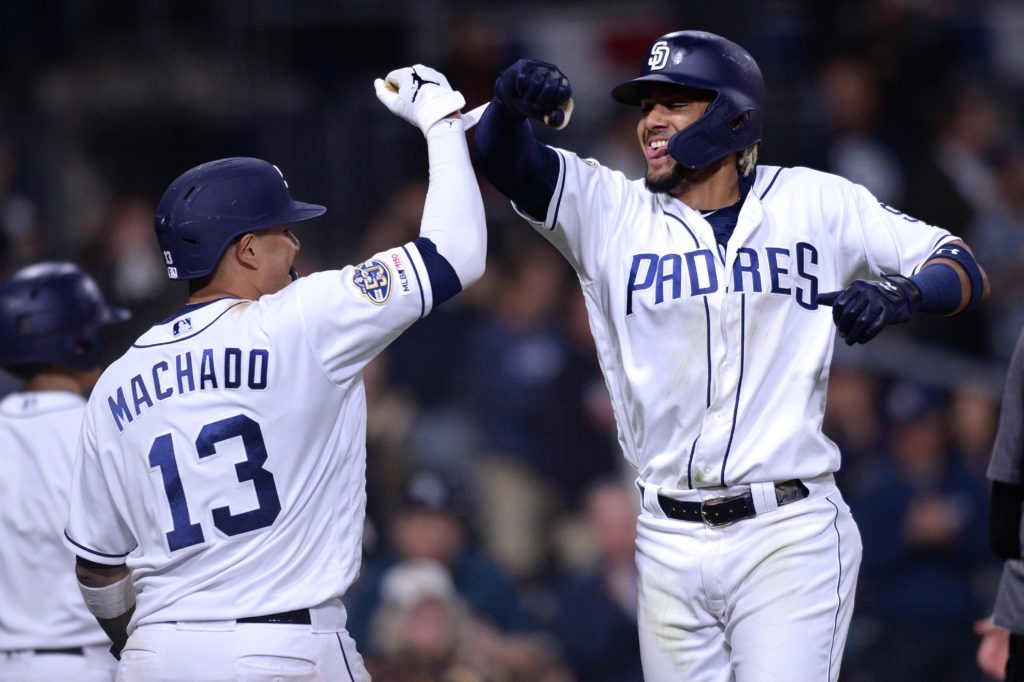
Mandatory Credit: Orlando Ramirez-USA TODAY Sports
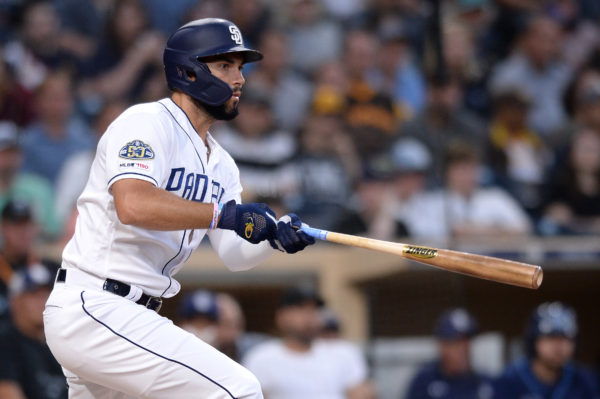
Your grades for the 2019 San Diego Padres infield.
The 2019 baseball season has finally come to a close for the San Diego Padres, and there were plenty of reasons to be disappointed. The team had a good first-half but, as the season moved past June and July, the team’s performance sagged, and the record showed.
For now, we look at the Padres infield and grade each player based on their 2019 performance. Seven players will be graded, but not included will by Seth Mejias-Brean and Wil Myers, as Mejias-Brean played in only eight games while Myers was primarily an outfielder this season.
Fernando Tatis Jr.: A-
The energetic shortstop was one of the few bright spots in a beleaguered 2019 season, Tatis was a serious threat to win the National League Rookie of the Year award until a back injury shut him down. The 20-year-old was a human highlight reel as he hit towering home runs, made tumbling plays at shortstop, and even scored on a pop-fly to the second baseman not once, but twice.
Batting .317/.379/.590, Tatis hit 22 home runs while swiping 16 bags. While he struggled against offspeed pitches, hitting only .191 against 160 offspeed pitches, Tatis absolutely crushed fastballs by collecting a .378 batting average and slugging .684 with 16 home runs against the 775 fastballs he saw.
Tatis was full of surprises this year. The rookie beat out 18 infield hits while his uncanny ability to suppress slumps arose due to his willingness to be coached and make adjustments to his game. His speed, what was once noted as just merely average, has now become a core part of his game, allowing for stretching a mere single into a double or making a defensive play in a position that no shortstop could ever dream of fielding.
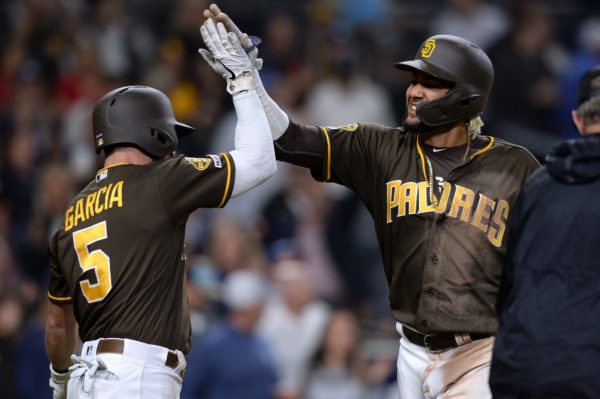
If there is one problem with his game, it is his strikeouts. Statcast rates his chase percentage at 29.7% while his whiff rate clocks in at 35.3%, leading to a strikeout percentage of 29.7%, a rather high and slightly worrying number that could become a problem if left unchecked.
This is just a small blip on the radar in what was a successful rookie campaign. He is the heart and soul of this team, and he is going to be a Padres for many years to come. It will be a privilege to watch him grow into an even better character.
Manny Machado: B
The multi-million dollar man himself, Machado, started the season with quite a bang…only to fizzle out at the very end. Machado himself stated that he believed that his performance wasn’t up to expectations.
Perhaps what plagued him most was the bad case of striking out, as his strikeout rate rose from 14.7% in 2018 to 19.7% in 2019. Statcast could provide an answer to his issues, as not only did he swing more often on first pitches (32.9% in 2018 to 36.9% in 2019), his whiff rate also saw a two-percent bump. Plus, while his 2019 chase rate was only one-tenth less than what it was in 2019, his overall chase contact rate was down three percent from 2018.
His .247/.334/.462 batting line eas certainly a downgrade from last year’s combined efforts with the Baltimore Orioles and the Los Angeles Dodgers, but Machado was still a dangerous hitter with runners in scoring position, going .277 with a .903 OPS with runners in scoring position. Ever the power threat, Machado launched 32 home runs, his fifth straight year where he has hit over 30 home runs.
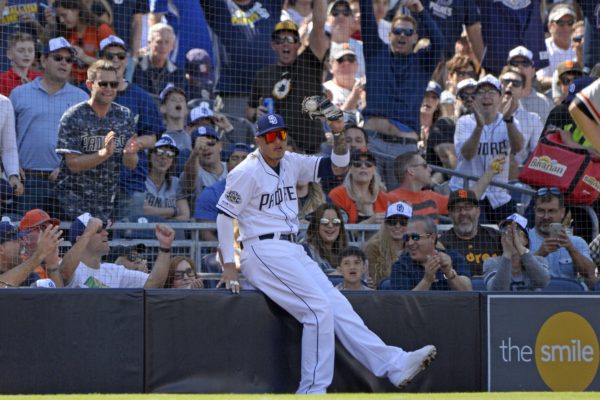
With the glove, Machado proved why he was called “El Ministro.” Like Tatis, he made many a highlight-reel play at the hot corner while collecting a +5 Defensive Runs Saved metric in the 1040 innings he spent at third base this year.
Off the field, Machado took responsibility for his struggles and will have an entire offseason to shake it off. However, he has produced more in one season than many other Padres’ third baseman have in years prior, and he should only continue to get stronger as Padres gear up for a playoff push.
Eric Hosmer: C
On the surface, Eric Hosmer improved on his initial 2018 season with the Padres. He collected a .265/.310/.425 batting line while smashing 22 home runs and 99 RBIs. He even saw his ISO ratting jump from .145 in 2018 to .160 in 2019 while he cut down on his groundball rate by four percent.
However, looking behind the curtain, Hosmer had a slightly worse season this year. Yes, the home runs increased, but it came at the expense of his plate discipline. He posted a career-high 24.4% strikeout rate while his walk-rate dipped to a career-worst six percent.
His struggles against left-handed pitchers have been well documented. When batting against southpaws, Hosmer managed a batting line of .231/.280/.321 while hitting just one home run. It had gotten to a point where then-manager Andy Green was considering platooning Hosmer to protect him from left-handers. For a man getting paid $144 million to end up potentially platooning at first base should be seen as a crimson red flag.
His defense also took a turn for the worse as even owner Ron Fowler called out Hosmer in the twilight moments of the season. For a four-time Gold Glove winner, the mental mistakes Hosmer made were inexcusable and led to a career-high 14 errors on the field.
On the one hand, Hosmer provided veteran leadership and remained a staple in the lineup. On the other hand, an increase in strikeouts, poor fielding, and the inability to hit left-handers is a cause for concern.
Ian Kinsler: F
When Ian Kinsler was signed to a two-year, $8 million deal in the offseason, the expectation was that he would provide veteran leadership while coming off the bench in a pinch-hitter role. Instead, Kinsler was thrust into a starting job when Luis Urias and Ty France struggled in the Majors.
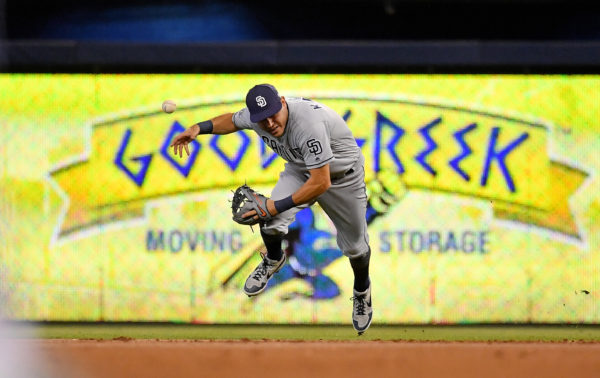
On the plus side, Kinsler provided veteran leadership. That is the only positive.
At the plate, Kinsler struggled, and then he struggled some more. He manufactured a meager .217/.278/.368 batting line with nine home runs. At some points in the season, Kinsler looked utterly lost at the plate while constantly whiffing through pitches.
After struggling with both the glove and the bat while having some… interactions… with fans, Kinsler was demoted to the bench once Urias returned in late-July and made his exodus on the season after suffering a season-ending neck injury.
Stuck at 1,999 career hits in his 13 years of service, Kinsler may not get a shot to get that 2,000th career hit as San Diego may be better off sending him packing and eating the rest of his contract. Should this be the case, Padres’ fans will undoubtedly pack his bags for him and buy him a ticket out of San Diego.
Greg Garcia: B
Who would’ve known that the former St.Loius castoff would be one of the most consistent hitters in the Padres lineup? The former Cardinal was picked up by the Padres off of waivers and, like Kinsler, was thrust into a starting role after injuries forced Green’s hand.
On a team with significant problems with getting on base, Garcia was one of few players who made positive strides in that aspect. Carrying a .364 on-base percentage, good for second place on the team amongst players with at least 300 at-bats, Garcia started to get more and more playing time as other players struggled at the plate.
Even with a strikeout rate of 22.1%, the utility infielder still carried an impressive 14.2% walk rate on the season. The former Valhalla Norseman was a versatile Swiss Army Knife as well, bouncing around the field to play at least one inning at every position except catcher, right field, and center field.
The 29-year-old is still eligible for arbitration and, while he won’t be a starter as long as Urias and Tatis remain in the Majors, he would still make an excellent utility infielder on next year’s club.
Ty France: C+
There were times this season that Ty France looked like the Pacific Coast League MVP, like when he walloped two home runs in a game against the San Francisco Giants. Or there were the other times where he looked overmatched at the plate while trying to adjust to a new position.
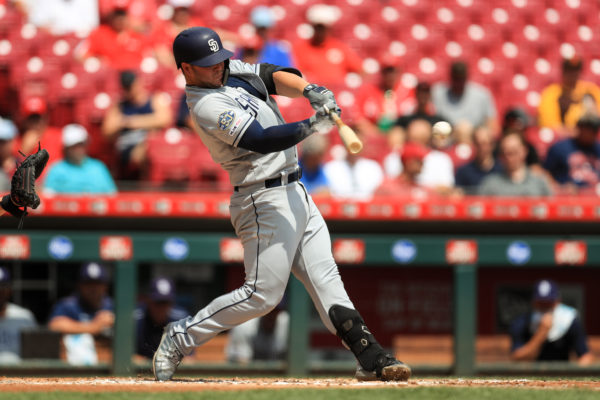
France piled up accomplishments with El Paso, hitting .399 with a 1.247 OPS while winning the Triple-A Home Run Derby and winning the aforementioned MVP, but that success didn’t exactly translate to the Major Leagues, as he hit .234/.294/.402 with seven home runs.
Keep in mind that France was also learning how to play a new position as his natural position, third base was blocked by one Manny Machado. He handled himself well at second base, not committing a single error at the keystone, while even filling in at third base to spell Machado.
He will receive a chance to start at second base, depending on how he and Urias perform during Spring Training, but he will have to start hitting as he did at El Paso to stick with the team in the long run.
Luis Urias: C+
Let’s get one thing clear; Urias is a second baseman, not a shortstop. He can fill in occasionally at shortstop, but the multiple sloppy performances and nine errors as opposed to the one error he made at second base.
Similar to last year, he also looked overmatched at the plate. Gone was the simple contact approach, and in came an all-power push complete with an inconsistent leg kick that he struggled to get the timing of. It also didn’t help that, in his initial call up, he received little playing time which undoubtedly created some confidence issues in the 22-year-old, leading to him getting sent down again.
Once Urias returned in late July, he continued to struggle until September, where the infielder finally caught fire. He went on a nine-game hitting streak while raising his batting line from .178/.306/.267 at the beginning of September to .223/.329/.306 after the final game was played.
[wpedon id=”49075″ align=”right”]
Urias still has plenty of things to improve on. For example, his 22.5% strikeout rate is still a cause for concern, but it is balanced out by a 10.0% walk rate. However, he only compiled a WRC+ of 81 and has scuffled against major league fastballs, batting only .218 when faced with a heater.
His torrid pace and top prospect pedigree, however, give him a slight edge over France when the time comes for a Spring Training battle for second place.
I am currently attending San Diego State University while working on achieving a major in journalism. At SDSU, I write for The Daily Aztec while also hosting the sports radio show “Picked Off”, for KCR Radio. A loyal fan of San Diego sports, I hope to bring content that you will enjoy reading.
I agree that WAR should be a criterion for grades. Wins Above Replacement (WAR) should dictate grades. If 0 WAR is the worst MLB first basemen, then the other commenters are correct an F should be in order.
According to Fangraphs, Hosmer “earned ” a WAR value of -0.4, the worst on the team. How is this not an F?
That was a terrible analysis, stopped reading after that.
This might be quibbling, but I am not sure how Tatis gets anything but an A+ (unless you include his injuries and lack of availability, which you did not mention in your critique and criteria).
Other than with Hosmer I think you did a great job, and there is a lot to look forward to with this team. However, speaking of Hosmer …
“On the one hand, Hosmer provided veteran leadership and remained a staple in the lineup.” He did? If so then he did a really poor job. The talent this year was far better than last year, and they still ended up LAST. Also, you describe remaining in the line-up as if this is a positive for him, as if he merited this and deserved this. Unfortunately, his catastrophic contract is the only reason he “remained a staple in the lineup.” That is negative a million times over. Hosmer was the worst defensively, and nearly the worst, if not the worst offensively. And you give that a C? This in a year when back up outfielders hit 30 home runs (and Hosmer was “smashing 22 home runs”)?
I normally love your work Jason but you get an F for giving the worst first baseman in the league a C. That is inexplicable.